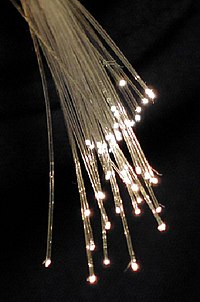
Photo from wikipedia
A Mie-based forward modeling procedure was developed to reconstruct bulk inherent optical properties (IOPs) from particle size distributions (PSDs) and real refractive index distributions (PRIDs) obtained using a previously developed… Click to show full abstract
A Mie-based forward modeling procedure was developed to reconstruct bulk inherent optical properties (IOPs) from particle size distributions (PSDs) and real refractive index distributions (PRIDs) obtained using a previously developed flow cytometric (FC) method [Appl. Opt.57, 1705 (2018)APOPAI0003-693510.1364/AO.57.001705]. Given the available PSDs, extrapolations for the particle fraction outside the detection limits of the method and a complex refractive index input (with real part nr directly estimated and imaginary part ni adapted from the literature separately for organic and inorganic components), the model produces volume scattering functions that are integrated to produce scattering and backscattering coefficients, and absorption efficiencies that are used to calculate absorption coefficients. The procedure was applied to PSDs and PRIDs derived from natural samples retrieved in UK coastal waters and analyzed using a CytoSense flow cytometer (CytoBuoy b.v., The Netherlands). Optical closure analysis was carried out between reconstructed IOPs and in situ IOPs measured using an ac-9 spectrophotometer and a BB9 backscattering meter (WET Labs Inc., OR) in the same waters. The procedure is shown to achieve broad agreement with particulate scattering (bp) and backscattering (bbp) [root mean square percentage error (RMS%E): 35.3% and 44.5%, respectively) and to a lesser degree with backscattering ratio (b˜bp) (RMS%E: 77%). The procedure, however, generally overestimated particulate absorption (ap) (RMS%E: 202.3%). This degree of closure was dependent on applying recently developed scattering error corrections to both absorption and attenuation in situ measurements. Not only do these results indirectly validate the FC method as a useful tool for PSD and PRID determination in natural particle populations, they also suggest that Mie theory may be a sufficient model for bulk IOP determination, with previously reported difficulties potentially being caused by inadequately corrected IOP measurements. Finally, in a feature unique to the FC method, the concurrent size and refractive index retrieval enabled assessment of the relative contributions that organic versus inorganic, fluorescent versus non-fluorescent fractions of the particle populations had on the IOPs, and identified which size classes had the largest influence on each of these properties.
Journal Title: Applied optics
Year Published: 2018
Link to full text (if available)
Share on Social Media: Sign Up to like & get
recommendations!